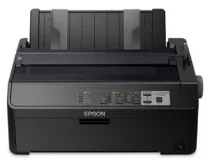
Epson FX-890IIN Printer Software and Drivers for Windows and Macintosh OS.
Microsoft Windows Supported Operating System
Windows 10 (32/64 bit)
Windows 8.1 (32/64 bit)
Windows 8 (32/64 bit)
Windows 7 SP1 (32/64bit)
Windows Vista SP2 (32/64bit)
Windows XP SP2 (32/64bit)
Supported OS:Windows 10 32-bit & 64-bit, Windows 8.1 32-bit & 64-bit, Windows 8 32-bit & 64-bit, Windows 7 32-bit & 64-bit, Windows Vista 32-bit & 64-bit, Windows XP 32-bit & 64-bit
Apple Supported Operating System
Mac OS X 10.15 Catalina
Mac OS X 10.14 Mojave
Mac OS X 10.13 High Sierra
Mac OS X 10.12 Sierra
Mac OS X 10.11 El Capitan
Mac OS X 10.10 Yosemite
Mac OS X 10.9 Mavericks
Mac OS X 10.8 Mountain Lion
Mac OS X 10.7 Lion
Mac OS X 10.6 Snow Leopard
Mac OS X 10.5 Leopard
printer driver for mac
Epson FX-890IIN Specifications
The Epson FX-890IIN is an efficient, no-nonsense, and sturdy dot matrix printer developed to meet the harsh print demands of high-volume printing. It is a printer known for reliability in suiting different print environments such as warehouses, banks, and schools. This device has high print speeds, reaching up to 738 characters per second at 12 CPI. Moreover, this model boasts a mean time between failure rating of 25,000 power-on hours, a seemingly infallible proof of its inherent dependability. In addition to these maximum figures, it would appear that this printer’s primary advantage is time efficiency.
The separation from the former dot matrix, which I scrutinized, the FX-890, is modeled to guarantee it can run for many hours and days without breaking down. The business has kept running costs by incorporating an energy-saving design, which is a considerable advantage for firms that wish to save on energy expenses. In addition to the energy-saving designs, the ribbons designed for the device’s usage are pretty durable; each ribbon can produce up to 12 million characters.
As such, low operational costs imply low total operational costs and perhaps insinuate a closer agreement with the requirements of schools than other devices evaluated. It does not mean that this printer’s performance is lacking. For example, it supports a variety of 7-part forms, which was likely a feature the business anticipated schools would find highly beneficial. However, it also means that the developer’s claims regarding efficiencies and cost-saving steps are too many and that the device perfectly caters neither to schools nor businesses in search of advanced graphic printing options.